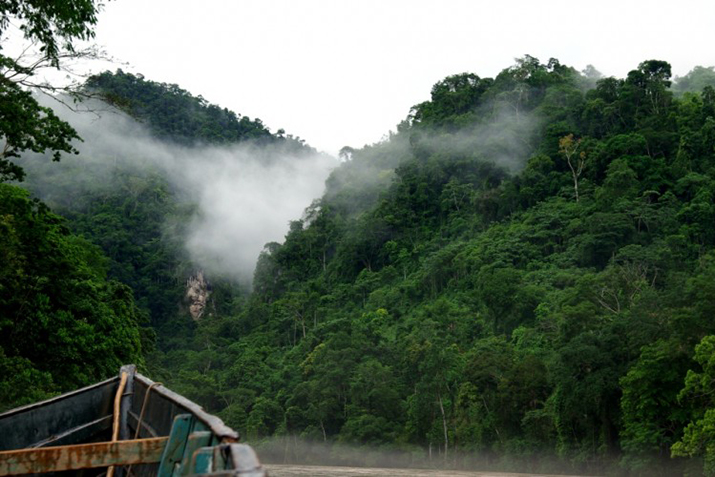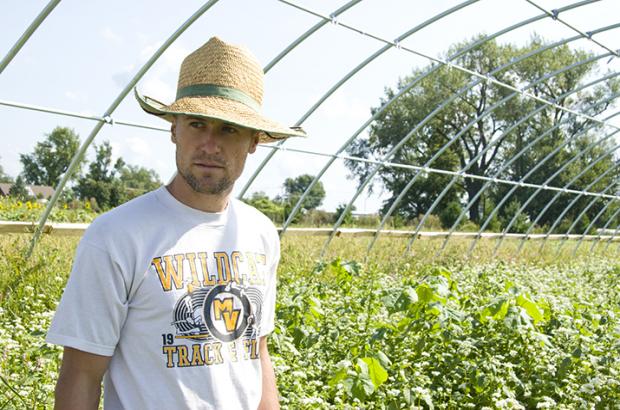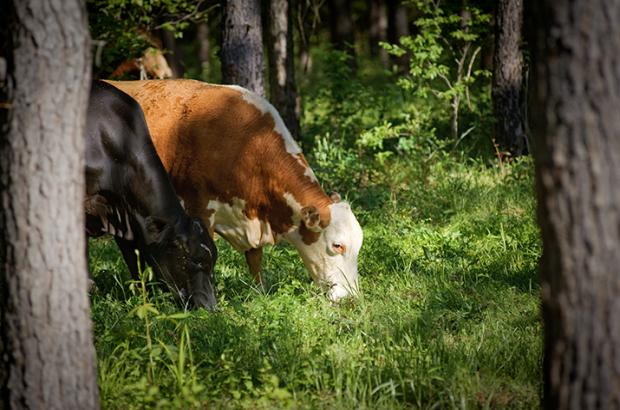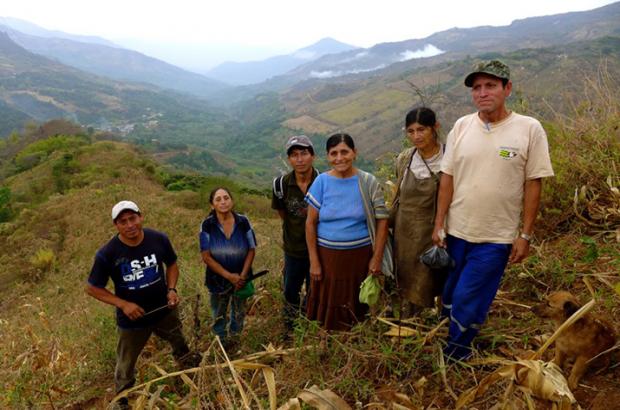Article
Co+op Forest Carbon Offset Program Slows Climate Change

Archived article. Project is complete as of 2022.
Paddle up the Huayabamba River in northern Peru, and amidst the roar of breathtaking waterfalls and chatter of tropical songbirds, you’ll come across the Co+op Forest. This lush, mountainous landscape is thought to be one of the most bio diverse regions in the world, home to over 160 mammal species, more than 300 bird species and hundreds of butterfly, amphibian, reptile and plant species as well.
It is paradise, but sadly much of this region is recovering from decades of deforestation, while its remaining old growth forest remains at risk for petroleum development. But thanks to intervention by concerned cooperative businesses, this region continues to play a meaningful role in slowing climate change.
Food co-ops seek to tangibly slow down the rate of climate change
Since 2012, the Co+op Forest has been thriving under the stewardship of a carbon offset program funded by National Co+op Grocers (NCG), the organization behind this website, in partnership with PUR Projet. NCG believes that environmentally responsible businesses like food co-ops have an important leadership role in addressing climate change.
The idea behind this unique carbon offset program is simple: NCG calculates their annual carbon emissions (from business travel, utilities, etc.), then funds the planting or protection of a corresponding number of trees to absorb (offset) that carbon. When trees naturally absorb carbon dioxide—a greenhouse gas—from the atmosphere, it effectively slows the rate of climate change.
Responding to the climate crisis through rainforest reforestation & conservation projects
Co+op Forest includes both reforestation and conservation projects. Reforestation projects, in which farmers plant native tree seedlings, are important because as these trees grow they are absorbing carbon dioxide from the air and storing some of the carbon in their trunks. Planting native trees in tropical areas is especially beneficial because tropical trees reach maturity quickly, allowing them to store more carbon over their lifetimes.
Conservation projects protect old-growth trees from being clear-cut for timber, or burned to make way for crops or other development. Protecting these trees is critical because their massive trunks are made up of tons of tiny carbon atoms; every carbon atom that remains locked up in a tree is one less carbon atom that will otherwise contribute to global warming.
Co+op Forest supports fair trade farmer cooperatives, improves quality of life
Co+op Forest is also unique because it is grown in a way that respects the surrounding Peruvian community, ensuring that they benefit from the project, too. Drawing on the rich South American tradition of embracing the cooperative model, NCG partners with fair trade, organic farmer cooperatives to plant and maintain native trees in Co+op Forest. The cooperatives offer training to farmers in sustainable agroforestry because protecting the native forest around their farms produces higher quality fruits and reduces erosion, improving water quality for the entire community. Additionally, Co+op Forest trees that farmers plant on their own land will eventually provide them with much-needed retirement income from sustainably harvested FSC-certified timber.
See how we've grown! Co+op Forest milestones
As of 2021, Co+op Forest includes an estimated 1.8 million trees which will offset at least 7,052 metric tons CO2e within their lifetimes, while also providing income and environmental benefits to the surrounding community.
Learn more about our annual projects below and check out the video to take in some of the region’s breathtaking landscape and get a sense of why this work is so critical.
2012 - A partnership sprouts
NCG staff travel to Peru to meet with PUR Projet and members of the ACOPAGRO farmer cooperative, which produces organic cacao. While visiting the region, NCG staff join PUR Projet and ACOPAGRO farmers to plant what will become the first Co+op Forest native tree seedlings among the crops.
2013 - Co+op Forest takes root
Inspired by the potential to make a meaningful impact, NCG commits to offsetting carbon emissions associated with annual business travel and becomes PUR Projet’s first U.S. partner to plant trees as part of the Alto Huayabamba reforestation project. NCG calls it Co+op Forest. Native Trees Planted: 1404.
2014 - Co+op Forest expands to protect old-growth trees
In addition to business travel, NCG begins tracking and offsetting emissions associated with gas and electric utilities in its offices. Co+op Forest expands to include the San Martin BioCorridor, an old-growth forest located just up river from the existing project. This conservation project protects a highly biodiverse region which is at-risk for petroleum extraction. Native trees planted: 1,100. Acres of protected forest*: 1,226.
2015 - Co+op Forest branches out
Co+op Forest expands to support a reforestation project in the Alto Shamboyacu community, home to roughly 150 families, many of whom are indigenous Quechua belonging to the Oro Verde cooperative. In addition to producing organic, fair trade chocolate and coffee, the Oro Verde co-op is revitalizing indigenous beekeeping to help pollinate crops, improve biodiversity and provide farmers with additional income. Native trees planted: 2,187. Acres of protected forest*: 1,201.
2016 - Co+op Forest region internationally honored
Due in part to NCG’s continued support, the region in which Co+op Forest resides is honored as UNESCO Biosphere Reserve, to serve as a model of sustainable communities. Native trees planted: 600. Acres of protected forest*: 2,634.
2017 – Co+op Forest regenerates farmland
Seeking a solution to the over one million acres of degraded farmland produced by years of slash-and-burn deforestation in the region, local farmers join with PUR Projet and funders like NCG to undertake a new farmer-led project, Finca a la Media. Together, they plant trees to reduce erosion and improve the soil, so farmers don’t have to cut down old growth rainforest for new farmland. Farmers also learn methods such as agroforestry and carbon (or regenerative) farming, which according to Project Drawdown, show promise to help slow global warming. Trees planted: 1158 Acres of protected forest*: 1907
2018 – Co+op Forest funds farmer-led climate solutions
NCG funds the planting of 377 sustainable timber trees for farmers participating in Finca a la Media, further empowering the community to put climate solutions like agroforestry and farmland restoration into practice. These practices improve crop resiliency and income security for farmers in a changing climate. Native trees planted: 2,777. Acres of protected forest*: 340.
2019 – Co+op Forest investment increased in response to climate crisis
In 2019, the Amazon rainforest endured the most destructive fires in almost a decade. Over 2,000 square kilometers of rainforest were burned in July alone. In addition to the planting of over 3,270 trees in the Jubilacion Segura program and an additional 82 trees for Finca a la Media agroforestry project to offset 2018 carbon emissions, NCG increased their investment with the planting of another 7,000 trees to show solidarity with the fair trade farmers within food co-ops’ supply chain. Native trees planted: 10,352.
2020 – Co+op Forest offers hope during a trying time
In a year marked by crisis and tragedy, planting trees is a welcome, tangible act of hope for the future. NCG planted 3,348 native tropical trees in 2020 to offset 2019 carbon emissions. The year’s historic wildfires in the Western U.S. underscore scientists’ observations about how these natural disasters have increased in size and intensity because of climate change. The need for global reforestation efforts remains urgent. Planting native trees in tropical areas is especially beneficial because tropical trees reach maturity quickly, allowing them to store more carbon over their lifetimes. Native trees planted: 3,348.
2021 – Keeping focus on regenerative supply chains, Co+op Forest moves to Brazil
With the projects in Alto Huayabamba, the San Martin BioCorridor and Alto Shamboyacu drawing to a close, NCG chose to expand its impact in 2021 by moving the focus of Co+op Forest to Brazil, where they join international partner PUR Projet and the French National Forestry Office (ONF) in funding an established farmer training and reforestation project at the Fazenda São Nicolau in the state of Mato Grosso, Brazil. With their carbon emissions greatly reduced due to the COVID-19 pandemic in 2020, NCG nevertheless chose to fund Co+op Forest at the same amount as prior years. Rainforest trees planted: 3,000.
*Acres of old-growth forest protected in the San Martin BioCorridor. Depending on maturity and species of trees present, each acre is home to between roughly 200 to 600 trees.













